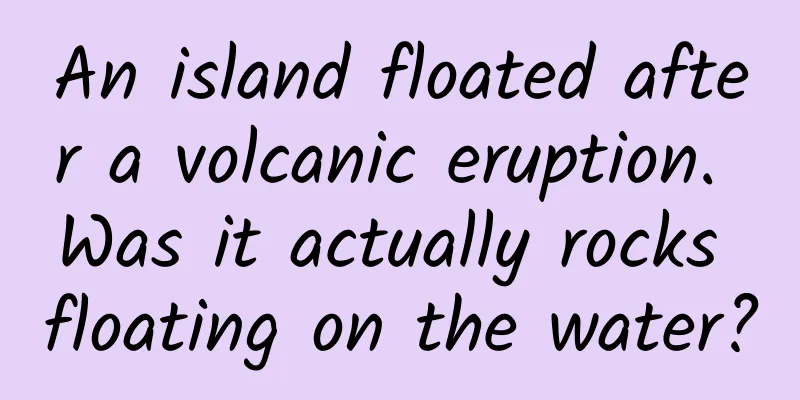An island floated after a volcanic eruption. Was it actually rocks floating on the water?

|
Recently, the Philippine Institute of Volcanology and Seismology announced that from 5:00 a.m. on July 31 to 5:00 a.m. on August 1, Mayon Volcano intermittently spewed volcanic ash and 100 rockfalls occurred. Among the rocks spewed out by Mayon Volcano, some were pumice. Previously, in 2021, pumice from an underwater volcano covered a bay in the Philippines, and waves pushed the pumice to the shore, forming a narrow embankment. Pumice is hard and brittle, with a rough and porous surface, and is generally white, gray, or red. The idioms "stone sinks into the sea" and "the truth comes out when the water falls" both mean that stones are heavier than water. If you throw stones into the water, they will sink to the bottom, so it is common sense that stones sink when they enter the water. However, pumice subverts people's cognition and becomes an unsinkable stone. The reason why stones can float on the water surface can be traced back to their "birth". Bad-tempered submarine volcanoes gave birth to pumice The "birth mother" of pumice is the ill-tempered volcano. Any violent volcanic eruption may produce pumice. Specifically, pumice is a glassy rock with dense pores and sponge-like shape, which is formed when the pressure of the magma decreases sharply after the volcanic eruption, and the internal gas quickly overflows and expands. Generally speaking, the pumice produced by volcanic eruptions on land is no bigger than a golf ball, while the pumice produced by submarine volcanoes directly sprays magma into the sea, and the pumice produced is generally the size of an apple. Most pumice stones are full of pores, which look like solidified bubbles, accounting for more than 70% of the total volume of the pumice stone. Therefore, the density of pumice stone is much smaller than that of water, and the minerals composed of silica only account for a small part, so they can easily float on the water. If a submarine volcano erupts and spews out a large amount of pumice, it is possible for the waves to gather together to form a large pumice area, like an island or bamboo raft floating on the sea. Therefore, it is called a pumice raft. The thickness can reach tens of centimeters and the length can reach tens of kilometers or even hundreds of kilometers. The Secret of the Rise and Fall of Pumice Rafts Some people have observed that there are some special islands in the ocean. They are small, movable, and rise and fall at dusk, which is very strange. Therefore, some people have a wild imagination and think that they are probably not islands on the earth, but secret bases hidden by aliens on the seabed, which come out during the day to secretly observe human activities. In fact, such floating islands are likely to be pumice rafts. They can drift for a long time and eventually sink to the bottom of the sea. Of course, some pumice are washed ashore and become part of the beach. The rise and fall of pumice rafts in the morning is related to the gas in the pumice. During the day, when the temperature is high, the bubbles in the pumice expand and produce greater buoyancy, while at night, when the temperature drops, the bubbles become smaller, water seeps in, and the pumice sinks. Most pumice stones have a strong ability to absorb water, and their pore structure is not completely sealed. As the gas is gradually lost, water invades, or they are soaked in seawater for a long time, the internal structure becomes looser and they may even gradually decompose, causing the gas to escape and eventually sink to the bottom of the sea. Pumice can be used as environmentally friendly and energy-saving material Pumice rafts formed by large amounts of pumice at sea pose a huge threat to maritime activities such as shipping, marine aquaculture, and marine ecology, affecting the navigation of ships. Fish in the sea will die from accidental ingestion. Pumice can also drift for a long time and over long distances under the influence of ocean currents, causing biological invasion incidents. Of course, scientists can also judge the intensity of a volcanic eruption and subsequent conditions by observing the color and amount of pumice ejected during a volcanic eruption. If red pumice appears in the ocean, it means that the volcanic eruption is very intense, and if too little pumice is ejected, it means that the volcanic activity will continue. At the same time, the drift of pumice is very important for the spread of marine life. The porous structure of pumice is rich in nutrients, creating living conditions for algae, coral polyps and other animals and plants, and is a paradise for marine life. These organisms follow the pumice to wander around the world and take root in new homes. Pumice has many excellent properties, such as fine texture, light weight, high strength, acid and alkali resistance, corrosion resistance, thermal insulation, sound absorption, fire resistance, and no pollution or radioactivity. It is an ideal natural green, environmentally friendly and energy-saving material, and is widely used in the construction industry and many fields of human life. (The author is a member of the Hunan Science Writers Association) |
<<: Half sober and half drunk! Can you drive after drinking "Jiangxiang Latte"?
>>: Popular Science Illustrations | Using Technology to Open the Door to Smart Cities
Recommend
How much suffering have those whose last digit on their ID card is X endured?
"Why does my ID number have a cross at the e...
A single picture makes you a god! Flies that grow mushrooms, lizards that blow bubbles, fungi that glow...
From insects controlled by parasitic fungi to wax...
Google Nexus 6 gets Android 7.1 update
According to foreign media Android Authority, the...
A guide to creating automotive-related short video content!
Hou Wenliang, 43, never dreamed that his interest...
There are fake public WiFi connections, will you regret it? Don’t ignore network security during the Spring Festival!
Network security risks during the Spring Festival...
Don’t ever say you don’t know these 13 wild cat species in China!
Cats are one of the most charming animals in natu...
What to eat on the beginning of summer? 9 must-eat foods recommended for the beginning of summer!
The first day of work after the May Day holiday wi...
Programming? Forget it. I'll just keep wandering.
[[131258]] In the summer of 2013, a man named Pat...
We need to sleep every day, but do you know how we wake up from sleep?
Produced by: Science Popularization China Author:...
Chinese people are the fastest growing people in the world! Have you contributed?
Earlier, the world-renowned medical journal "...
No New Year's Eve in 2022? It will be absent for the next five years
Did you find it? There will be no New Year's ...
Emotional Cycle Theory - Core Trading Course for Hot Money
Emotional Cycle Theory - Introduction to the reso...
91 Ten Articles: Tokyo Motor Show announced cancellation, Tesla has caused 175 deaths in eight years
1. Tesla Vice President Tao Lin recently admitted...
Haikou Mini Program Development Company, how much does it cost to develop a hardware mini program?
What is the price for developing a hardware mini ...









